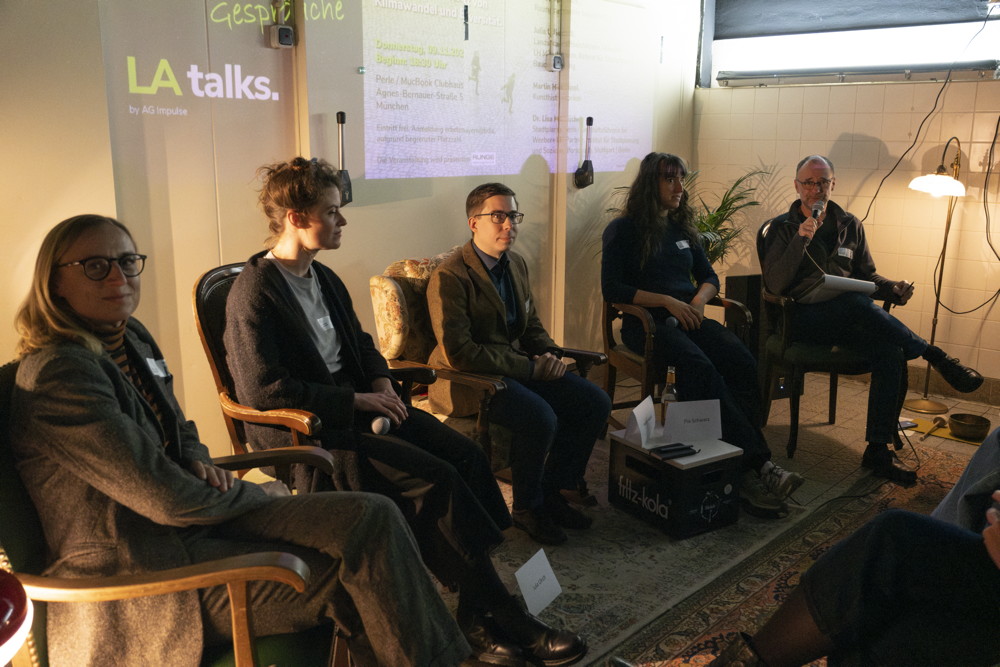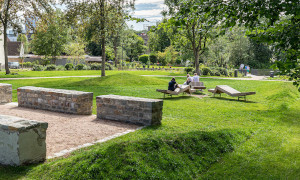"An experiment" - this is how moderator Andreas Rockinger began the series of events initiated by board member Nicole M. Meier and her bdla Bayern Impulse working group, which took place for the first time on Thursday, November 9 at the Munich interim use location and mucbook clubhouse "Perle". The main topic of the first edition was "Dealing with historical places and squares in the context of climate change and biodiversity".

The room was quickly filled and the seats allocated to colleagues and interested parties who accepted the invitation to discuss interdisciplinary approaches to current urban design issues.
"Green at any price (?) - Dealing with historic places and squares in the context of climate change and biodiversity" was the title of the first part of the interdisciplinary panel: Pia Schwarz (spatial planner at bauchplan), Julia Ulrich (landscape architect and building councillor of the City of Munich, Department of Urban Planning and Building Regulations), Martin Höppl (art historian, square researcher) and Dr. Lisa Küchel (urban planner and managing director at Weeber Partner, Institute for Urban Planning and Social Research) shed light on various aspects of this complex topic, first in a moderated discussion and later together with the audience.
{gallery}
To begin with, the four panel guests took on the roles of neighborhood manager, urban redevelopment employee, monument conservator and landscape architect. Using a jointly selected example square, they worked out and discussed existing qualities and deficits, potential for redesign and further development and the challenges that the project would entail.
In addition to different user requirements, the interests of mobility and traffic were weighed up against those of the quality of stay. In terms of safety, lighting plays an important role alongside escape routes, which in turn would be in conflict with biodiversity to a certain extent. Important urban climate potential was seen in the planting of trees and the establishment of façade greening, but architectural elements for shading as well as water features for cooling, the unsealing of paved areas and the uncovering of urban streams were also discussed as concrete measures for climate adaptation and climate protection. Dr. Lisa Küchel used a sample square to illustrate how difficult a planning process can become if it fails to take into account the different user requirements and involve all those involved. Even the implementation of an award-winning competition entry can then falter.
Could a greater willingness to experiment and temporary uses in line with the different user requirements possibly help to generate dynamic spaces in order to meet the different requirements?
This is an approach that building consultant Julia Ulrich put forward as a promising approach and which Pia Schwarz also called for, pointing out how important it is to communicate the need for action in a comprehensible way. The mediation task that planners have in this regard is of central importance. The aspect of time is equally important, as action must be taken now. Despite the importance of communication and participation, some things cannot wait that long, according to Dr. Lisa Küchel. It is not uncommon for good drafts to be talked about in a lengthy process and ultimately weakened in their impact. Only when the pressure of suffering is great enough will everyone become aware of the acute need for action, says Küchel and calls on people to go into politics, as this is the quickest and most democratic way to get involved as a planner in the long term and bring about concrete changes.
The deliberately provocative title "Green at any price (?)" was discussed controversially after an initial consensus on the need for action with regard to climate adaptation and biodiversity, namely when it came to the core content of the event: How do we deal with our historically valuable stock? Should we subject it to significant changes or why should we not be allowed to rethink it? Landscape architect and chairman of DGGL Bayern, Wolfgang Niemeyer, emphasized the importance of measures for climate adaptation and biodiversity on the one hand, but also the value of historic squares that have grown over decades and do not need to be redesigned. On the other hand, there are many other places in Munich that need to be improved in terms of climate adaptation and biodiversity. He also emphasized the tension between the alternation of stone and green open spaces.
Squares should not be viewed in isolation, but should be understood as an overall system within an urban structure that has different characteristics and qualities.
It is therefore important to identify the places where there is an acute need for action and those that should be preserved in their current form. In his own-initiative report, Martin Höppl already awarded Max-Joseph-Platz the status of an architectural square par excellence. Squares should not be viewed in isolation, but should be understood as an overall system within an urban structure that has different characteristics and qualities. Similar to human characters, every place has its own life story: some are born green spaces, others are not. However, he clearly spoke out against a generally applied, "static preservation" of squares. Instead, he sees change (of square design concepts) as the "actual basic principle of square design".
Franz Damm went one step further and expressed his doubts that historic squares must always be left as they were originally conceived. Instead, he argued that we should continue to build our cities and public spaces and adapt them to new requirements. Such unpleasant decisions should not be put on the back burner.
Not all green is the same
Whether it always has to be trees or whether climate adaptation in the historic old town can also be achieved with the help of other elements, such as shading elements and fountain installations - one thing is certain for Julia Ulrich: "The most beautiful square is of no use to us if no one can spend time there" and suggests that vegetation and its effect on the place should also be considered over the course of the seasons. Former city councillor Paul Bickelbacher takes a similar view. He reminded us of the different tools we have as landscape architects and that "not all green is the same", meaning that we can react very differently to different places.
It is up to us planners to highlight the complexity of projects and bring it to politicians to enable them to expertly negotiate compromises and adequate solutions.
The entertaining discussion revealed controversial approaches, which nevertheless seemed to reach a consensus on one point, namely that one of the main challenges is to develop an appropriate, site-specific approach. In this context, Doris Grabner rightly warned against unqualified quick action and emphasized the importance of an interdisciplinary approach supported by politics. Quick, knee-jerk solutions are usually not mature enough to do justice to the task at hand. It is therefore up to us planners to highlight the complexity of these projects and bring them to the attention of politicians in order to enable them to negotiate expert compromises and adequate solutions. The basis for this should be created through competitive procedures or multiple commissions. This is the only way to identify a range of alternative solutions that will enable the right decisions to be made.
The evening brought up many exciting aspects, which were discussed in a relaxed bar atmosphere after the official part of the event. We are particularly pleased that, in addition to representatives of our profession, the Vice President of the Bavarian Chamber of Architects Franz Damm and members of the DGGL and the Munich Forum, interested members of the public were also present. For the future, we have set ourselves the goal of addressing an even more diverse audience in order to realize our vision of LAtalks. Salongespräche as an interdisciplinary discussion forum in the long term.
The AG Impulse would like to extend a special thank you to
- the panel guests Pia Schwarz, Julia Ulrich, Martin Höppl and Dr. Lisa Küchel for their diverse perspectives on the topic
- Andreas Rockinger for his moderation
- Elisabeth Auer, office manager of bdla Bayern and board member Doris Grabner for the great organizational support
- the company Runge for sponsoring our event
- the Bavarian Chamber of Architects for their support as a cooperation partner
- the Perle: Mucbook Clubhaus andamp; Steinchen Kulturcafé for their hospitality
- all listeners and fellow panelists in the audience for their active participation
The next edition of LAtalks as part of the "Green at any price (?)" series is already in preparation for the first quarter of 2024. We will inform you in good time here on our website and via LinkedIn and Instagram.
Author: Nicole M. Meier, board member of bdla Bavaria, head of the Impulse working group and initiator of the LAtalks. Salon Talks
- Latitude: 0
- Longitude: 0


